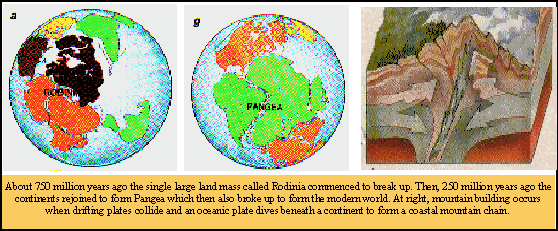|
Geophysics--further prophecies: Continental Drift and Age of the Solar System
"There is a curious parallel history between the histories of black holes and continental drift. Evidence for both was already non-ignorable by 1916, but both ideas were stopped in their tracks for half a century by a resistance bordering on the irrational…but [resistance to] both began to crumble around 1960." (Werner Israel, quoted in Thorne1)
"...disbelief (in continental drift) was so strong that it often bordered on indignation. One of the strongest opponents was the British geophysicist Sir Harold Jeffreys, who spent years attempting to demonstrate that continental drift is impossible because the strength of the mantle should be far greater than any conceivable driving force….It was in North America, however, that opposition to Wegener's ideas was vigorous to the point of excess and very nearly unanimous….Wegener was attacked from virtually every possible vantage point, his paleontological evidence attributed to land bridges, the similarity of strata on both sides of the Atlantic called into question, the fit of Atlantic shores declared inaccurate, and his very competence doubted."2
The idea of continental drift was mooted in the 19th century and first put forward as a comprehensive theory by Wegener in 1912. It was not well accepted, often being classified as pseudoscience. For example Rollin T. Chamberlin, a leading American geologist, wrote in 1928 just 6 years prior to receipt of the Urantia Papers: "Wegener's theory in general is of the footless type…It plays a game in which there are few restrictive rules…" Chamberlin then listed 18 points that he considered were destructive of the drift hypothesis and began his book with, "Can we call geology a science when there exists such a difference of opinion in fundamental matters as to make it possible for such a theory to run wild?"
In the light of such opposition one must wonder what would have caused the authors of the Urantia Papers to base the whole of their report on the evolution of continents and life on this planet upon the truth of continental drift--unless they had access to some special source of knowledge.
Moreover they were not simply following Wegener's version of drift. Wegener began his story with a single continent that he called Pangea that commenced to break up in the order of 200 million years ago. The story presented in the Papers commenced with a single continent that commenced to break up 750 million years ago. Wegener's views prevailed until around 1970 when some geologists began to voice a different opinion which is reported in a book entitled "Genesis" published in 19822. In this, it was proposed that there may have been a pre-existing continent, a Pangea 1, roughly 600 million years ago that had broken up into four new continents by about 450 million years ago, at the end of the Ordovician age. Then, about 250 million years later, these continents were thought to have converged to form Pangea 2 which quickly broke up again as proposed by Wegener. Variations on this theme have continued to appear and were pulled together in 1995 in a review article4 proposing the breakup of a pre-Cambrian supercontinent named Rodinia around 750 million years--exactly coincidental with the time given by the Urantia Papers.
There are other features of the Urantia Papers' story of our planet that are quite remarkable. Remembering the fierce opposition against continental drift that existed during time of receipt and publication of the Papers, their authors nevertheless associated the collision of the continental land mass and the oceanic floor with the formation of "the whole vast north and south mountain range extending from Alaska down through Mexico to Cape Horn." (Paper 60, Section 3) The collision of tectonic plates and subduction of the oceanic plate is now accepted as a major component of the forces involved in mountain building in areas like the west coast of the Americas.
The Papers also tell of features such as land bridges connecting Australia, and the Antarctic continent with South America and South Africa that would have allowed primitive placental (marsupial) animals that flourished 50 million years ago to move between these continents.
The presence of marsupial fossils in Oligocene strata (about 35 to 40 million years old) in Australia and in America in the Cretaceous strata dating as far back as 65 million years ago, together with the recent discovery of marsupial fossils on Seymour Island in Antarctica provide
|
|



